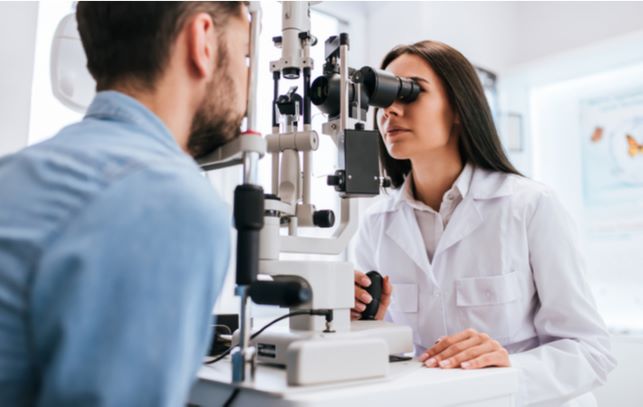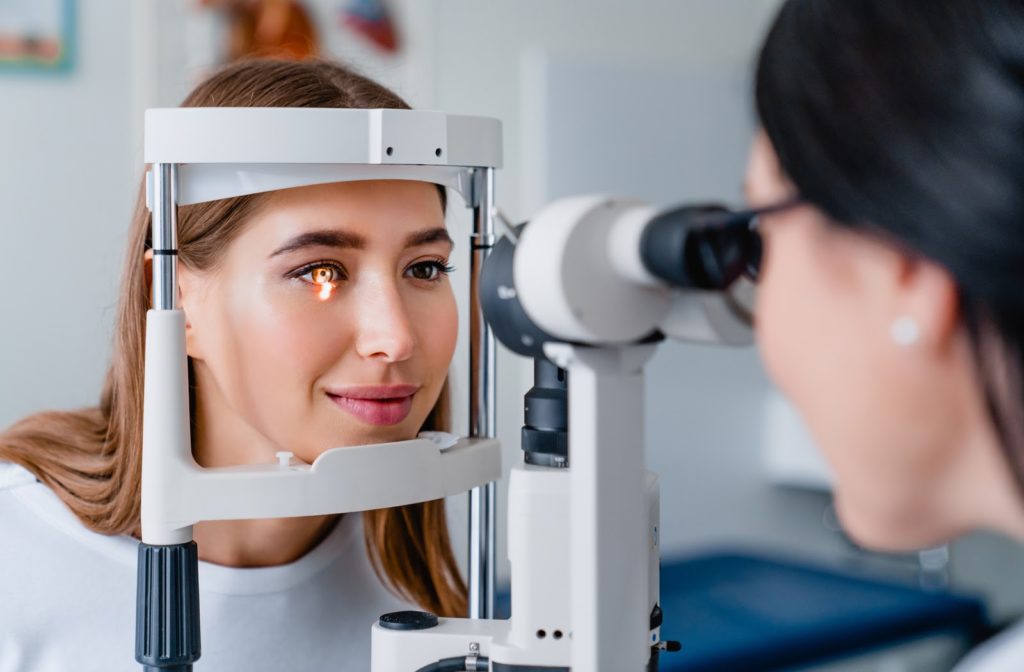If you’ve never had an eye exam before, or it’s just been a while since you’ve had one, you may not know what to expect. But don’t worry- we’re here to help you understand every moving part of your comprehensive eye exam.
During a routine (or comprehensive) eye exam, your optometrist will perform a wide range of tests and procedures to evaluate your vision and the health of your eyes. Sometimes these tests and procedures can use complex equipment to help your optometrist get the best view inside your eye.
The purpose of an eye exam is to help your eyes stay as healthy as possible. By getting regular eye exams, your eye doctor can help diagnose and manage diseases, update your eyeglass prescription, and keep track of how your eyes are ageing.
To help you understand what to expect for your next eye exam checkup, we put together a guide of what you might come across. Keep reading to learn about comprehensive eye exams, why they’re important, and how often you should get one.
What Happens During an Eye Exam?
A comprehensive eye exam typically takes 30 minutes to an hour. During your eye exam, your optometrist may perform any or all of the following tests:
Visual Acuity Tests
This test uses multiple sizes of letters on an eye chart to measure the sharpness of your vision. Your eyes will be tested together and separately to test the vision in both of your eyes.
Visual Field Tests
In a visual field test, your optometrist will evaluate your vision while you look straightforward. It helps your optometrist notice blind spots and examine your peripheral vision.
Pupillary Reactions Tests
During a pupillary reaction test, your optometrist will move light and objects in front of your eyes and observe your pupils’ reactions to them.
Alignment & Cover Tests
These tests allow your optometrist to see if your eyes are misaligned, which is known as strabismus.
To ensure that your eyes’ alignment is normal, your optometrist will ask you to follow an object as they move it in different directions and observe your eye movements.
A cover test can determine how well your eyes work together. They will ask you to focus on an object while they cover and uncover your eyes. This lets them see how much your eyes have to move to focus on the object, which may indicate an issue with alignment.
Retinoscopy
Retinoscopy is a technique that can test for refractive errors. Refractive errors affect how you see objects close to you or at a distance.
During a retinoscopy test, your optometrist uses an instrument called a retinoscope to see how light reflects from your eyes.
This test also helps your optometrist determine your approximate prescription.
Refraction
If your optometrist can’t determine your exact prescription through retinoscopy, they may use a refraction test to fine-tune your prescription.
During this test, your optometrist will ask you questions while flipping back and forth between different lenses on a phoropter. If you do not need vision correction, this test won’t be part of your eye exam.
The Slit Lamp Test
During a slit lamp test, your optometrist will examine multiple structures in your eye, including your:
- Eyelids
- Cornea
- Iris
- Lens
- Conjunctiva
- Optic nerve
- Retina
Because the slit lamp test allows your optometrist to examine your eye under high magnification, it can help them detect a wide range of eye conditions such as diabetic retinopathy or cataracts.
Non-Contact Tonometry
Non-contact tonometry (NCT) is also known as the “puff-of-air” test. During this test, your optometrist will use an NCT machine to deliver a concentrated burst of air into your eye. This measures the pressure inside of your eye, which helps your optometrist assess your risk for developing glaucoma.
Eye Dilation
While not included in all eye exams, your optometrist may choose to dilate (or enlarge) your pupils using dilation drops. This helps them to examine your retina better.
Dilation drops take about 30 minutes to enlarge the pupil fully and temporarily cause light sensitivity and blurry vision. These effects can last for several hours after your exam, so you may want to bring sunglasses or arrange an alternative ride home.

When Do You Need an Eye Exam?
There are several reasons why you may need an eye exam. Apart from receiving regular check-ups, you may need to see your eye doctor if you are experiencing vision symptoms or have an eye injury.
Our general recommendation for how often you should get an eye exam is as follows:
- If you’re younger than 40 and have no vision problems, we suggest that you get an eye exam every 2 years.
- If you’re 40 or older, you should get your eyes checked annually or as recommended by your optometrist.
- If your doctor has diagnosed you with an eye disease or deem you at risk for developing vision issues, you should see an eye doctor every year.
- If you are experiencing any vision symptoms, you should see your optometrist for an eye exam as soon as possible.
Why Do You Need to Get Regular Eye Exams?
Eye exams play a critical role in your overall health.
Many serious eye diseases show minimal or no symptoms until they have progressed, making early detection vital in preventing future vision loss.
During an eye exam, your eye doctor performs multiple tests to spot initial signs of these diseases and helps you treat them before they get worse.
How to Find an Eye Doctor
If you don’t already have an eye doctor and need to have your eyes examined, you can:
- Ask your family or friends for recommendations
- Ask your family doctor for an eye care referral
If you have any questions about your eye health or how to book an eye exam, contact us today!


